
Refractive Lens Replacement Surgery
What is a Refractive Lens Replacement?
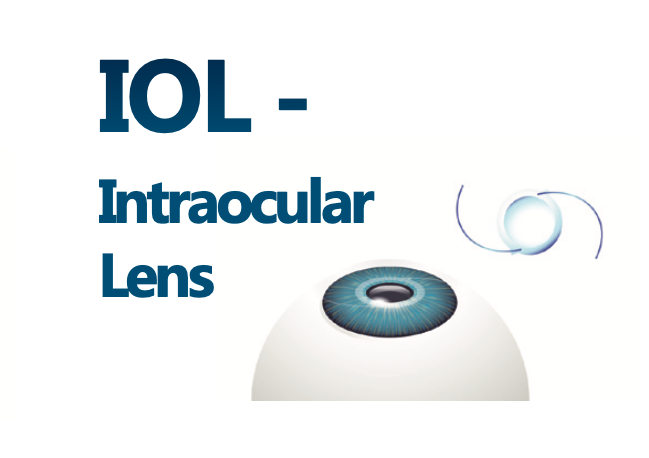
Suitability Criteria for a Refractive Lens Replacement:
Patients who:
- are older than 48 and presbyopic with reading vision problems
- are NOT suitable for Presbyond or LASIK
- have a desire to be spectacle or contact lens independent
- have no history of cataracts
- desire a permanent solution to be glasses independent
- have excellent corrected vision with glasses or contact lenses
- are completely dependent on reading glasses or multifocal glasses
- have healthy eyes and no other pathological diseases of the eye
Refractive Lens Replacement steps:
Advantages of a Refractive Lens Replacement:
- The need for glasses and contact lenses will be eliminated completely
- A cataract cannot form once a Refractive Lens Replacement has been performed
- The procedure is a permanent solution and no cataract surgery will be needed
- Contact lens wear risks are eliminated
- The operation is done in a day surgery
- Recovery is very quick and usually within 3 days
- No risk of worsening dry eyes as no flap is created
- Can be performed on patients with high spectacle errors who are unsuitable for laser eye surgery
- Significant savings in the long run by eliminating the need for constant optometric assessments, new glasses or contact lenses, contact lens solutions etc.
What Vision Can I Expect Long Term?
I will suggest the best option for you and your lifestyle during our consultation. Below are the several choices that I will most likely discuss with you, to optimise your vision for your lifestyle and ensure a lifetime of excellent vision.
1. Both eyes corrected for distance:
This option provides high quality distance vision but will require glasses for everything up close. It is a great option for people who do not mind wearing reading glasses. This option may suit people with a heavy vehicle licence or have an occupation that relies heavily on clear distance vision. A Monofocal lens is used in this option.
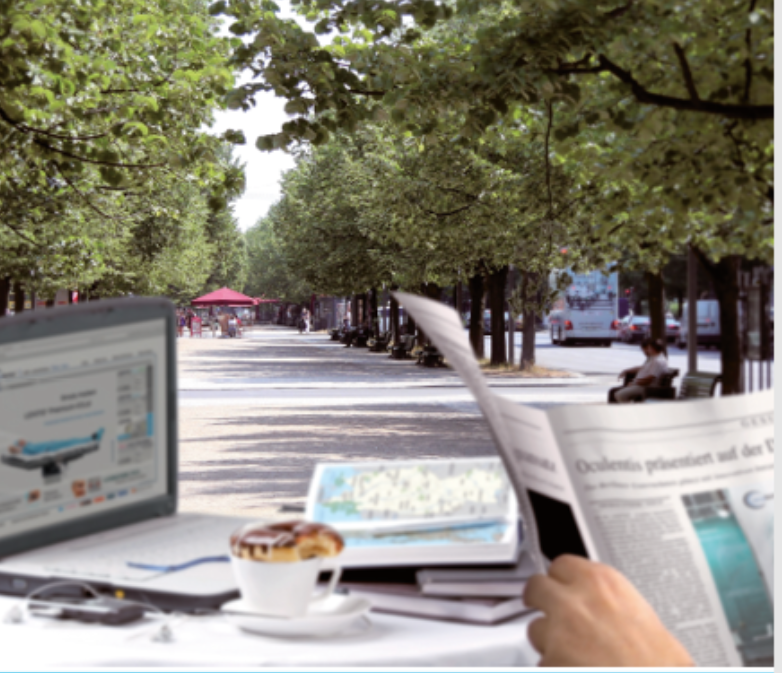
Simulated vision with monofocal lenses. Good distance vision where glasses are needed for computer work and reading
2. Blended Vision
This is where one eye is corrected for distance vision and the other for near vision similar to
Presbyond. This vision is often appreciated by people who only wear reading glasses or for many people who already wear this in their contact lenses. If we decide this is an option for you they may organise a contact lens trial for you to mimic the results of the surgery before proceeding. Monofocal PLUS lenses work exceptionally well in Blended Vision.
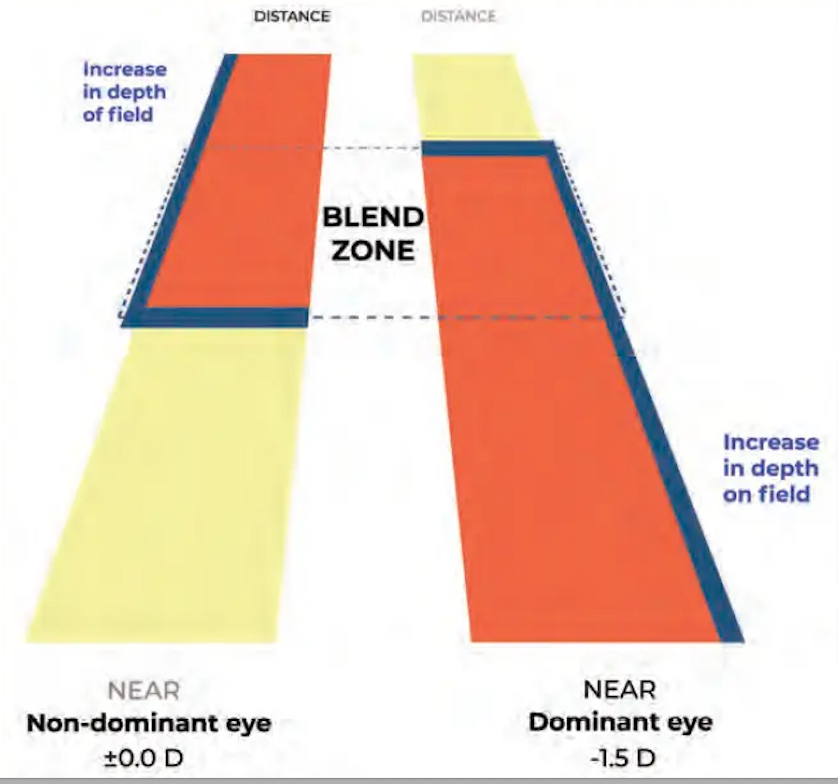
Pseudophakic Blended Vision in Monofocal PLUS lenses
3. Multifocal
This is becoming an increasingly popular option for most of my patients who desire complete spectacle independence. These lenses provide a high level of freedom from glasses and generally give good vision at all distances. They work very differently to multifocal glasses, so don’t be concerned if you have had problems with these in the past. There are a number of different brands of multifocal IOLs, all with slightly different focal points. I will advise you on the best lens for your lifestyle.
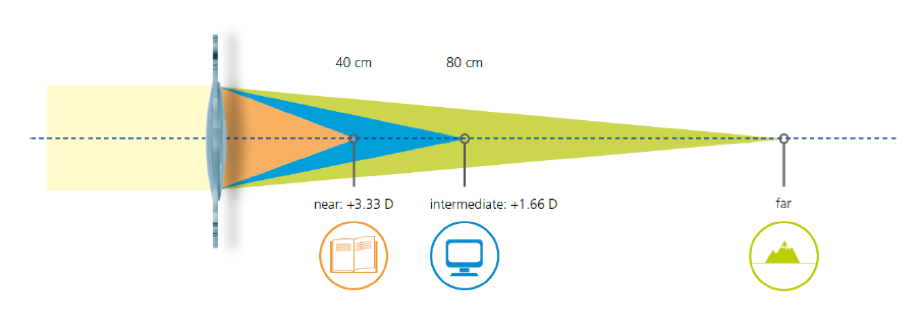
Multifocal lenses split light into 3 different focal points
4. EDOF
Extended depth of focus (EDOF) lenses is the latest form of intraocular lenses aimed at giving patients spectacle independence. They provide an excellent range of vision from near to distance. For small print reading glasses might still be needed. EDOF has much less nighttime glare symptoms than multifocal lenses with improved contrast or quality of vision.
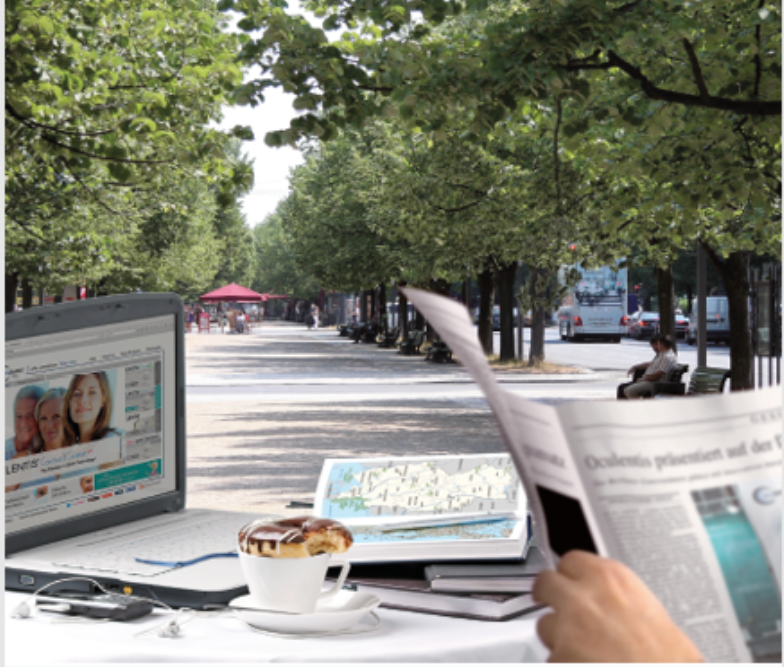
Simulated vision with EDOF lenses. Excellent distance and intermediate vison with functional near vision
Lens options in a Refractive Lens Replacement:
Not everyone is the same and not every patient has the same visual requirements. There are various different lens types available on the market to suit every individual.
I will perform an extensive and comprehensive analysis of your eyes, lifestyle and occupational needs to determine the best lens suited to you as an individual.
I will tailored your lens type to your specific needs and goals.
As a rule of thumb, the more spectacle free a patient wants to become, the more nighttime glare and quality of vision issues a patient will have. This is because as the range of a lens increases, the more extra optical properties a lens has. This can compromise your quality and night time vision.
Monofocal Lenses:
As the word “mono” (one) implies, monofocal lenses has only one focal point. These lenses can either be focussed for distance vision or near vision in both eyes.
Monofocal lenses as a rule do not cause nighttime glare and halo complications and the contrast sensitivity or quality of vision is not compromised

Example of a clear monofocal lens. These lenses have no extra properties and can either be focussed for distance or near vision- not both
Monofocal PLUS Lenses:
Monofocal PLUS lenses are highly versatile intraocular lenses that induce natural optical properties known as l spherical aberrations to enhance the depth of focus. In other words a single focal point with a little bit of extra range of vision around it.
As these lenses has a range of vision they can be implanted with different focal points in each eye giving patients “Pseudophakic Blended Vision”- very similar to
Presbyond.
Monofocal PLUS lenses do not cause glare symptoms at night and contrast or quality of vision is not affected
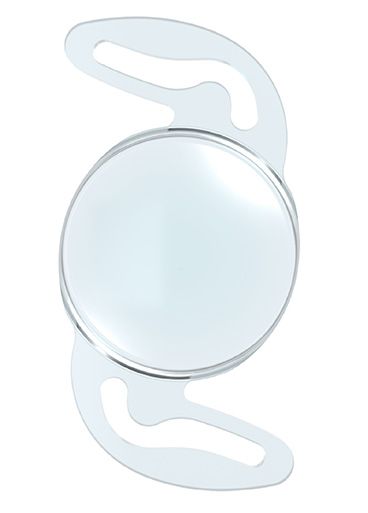
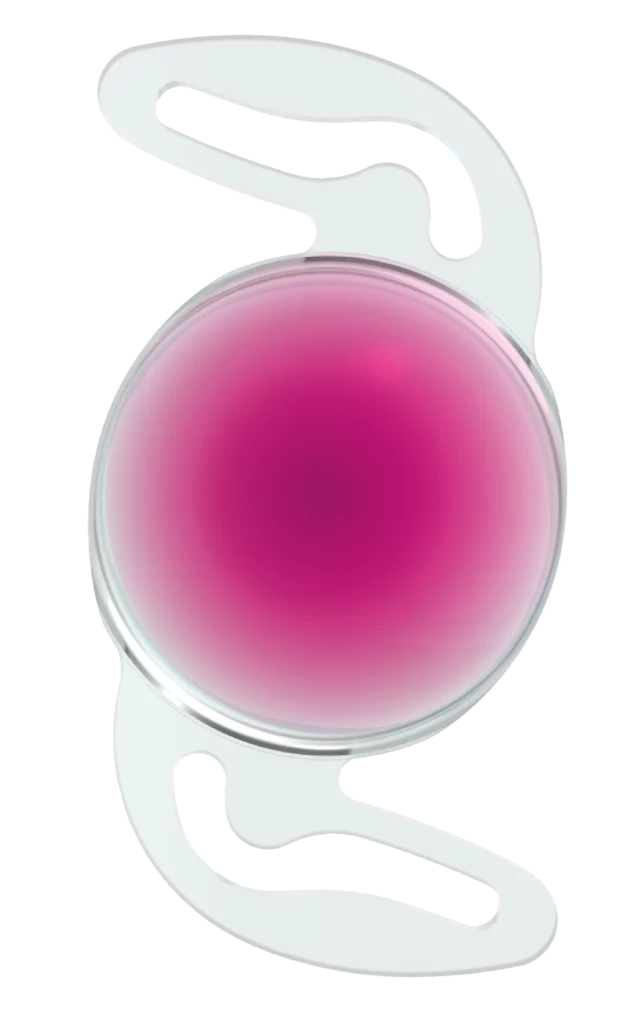
Example of a monofocal PLUS lens. These lenses have internal properties which induced natural optical phenomena known as spherical aberrations which enhances the patient’s depth of field
Extended Depth of Focus Lenses:
Extended Depth of Focus or EDOF lenses are the most modern type of lenses that can achieve spectacle independence.
EDOF lenses elongates a single focal point and gives an extra range of vision of 1.5-1.9 optical units or more.
These are extremely versatile lenses that can be implanted at various focal points to achieve spectacle independence.
EDOF lenses can also be used for Pseudophakic Blended Vision with an enhanced range with what is possible with Monofocal PLUS lenses.
EDOF lenses do cause night time glare though it is minimal and studies shows that most patients become accustomed to it over time.
Contrast sensitivity or quality of vision is minimally affected by EDOF lenses.

An example of an EDOF lens with extra properties in the lens to elongate the focal point
Multifocal Lenses:
Multifocal lenses give patients distance, intermediate and excellent reading vision without the need for reading glasses.
Multifocal lenses have rings (known as diffractive rings) in the lenses which splits light into 3 focal points, one for distance, one for intermediate and one for near vision. These lenses are general known as Trifocal lenses as they have 3 distinct focal points
With multifocal lenses patients are able to read small text comfortably without the need for reading glasses.
Because multifocal lenses have rings in them, they can cause glare and halo symptoms at night time.
Multifocal lenses are aimed at distance in both eyes.
Due to the rings and light splitting technology, both eyes can see distance, intermediate and near.
The advantage of multifocal lenses is that both eyes do not need to be focussed at different points.
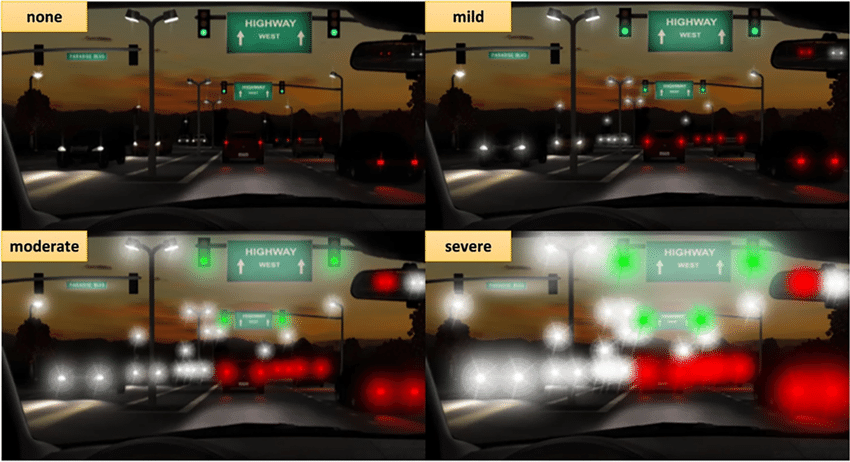
Glare and haloes induced at night time by multifocal lenses
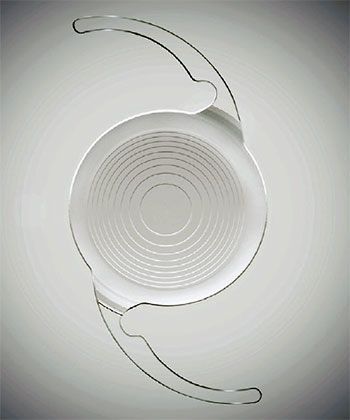
Example of a Multifocal lens with diffractive rings
A Refractive Lens Replacement or RLE is an operation that is similar to a cataract operation but is performed when no cataract is present . An RLE helps you see again without glasses when you’re older than 50 years of age and not suitable for Presbyond or you want a more permanent solution for spectacle independence.
During the RLE I expertly remove your natural clear lens and replace it with a premium artificial lens that will give spectacle independence or significantly reduce dependence on glasses or contact lenses. During an RLE I use the laser to perform precise incisions and create a perfectly round opening in the lens to ensure the most accurate outcome possible.
The artificial lens implant that I will insert in your eye will be chosen from several types of different intraocular lenses on the market. In most cases patients opt for multifocal lenses extended depth of focus lenses or a combination of both to become as spectacle free as possible . The intraocular lens that is chosen is based on each individual patient’s visual needs and I will discuss these options with you during our consultation so you as a patient make an informed decision about the most appropriate lens for your eyes.
- I perform a Refractive Lens Replacement 100% with drop local anaesthetic applied to the surface of the eye.
- Further unlike other centres in Western Australia, I do not use any needles to inject in the patient’s eye.
- I can also perform the surgery under general anaesthesia in certain circumstances.
- My aim is to keep my patient as calm and comfortable as possible for this life changing operation.
- A Refractive Lens Exchange takes me approximately 10 to 12 minutes per eye to complete. If the laser is used the procedure will take a few extra minutes.
- Both eyes are operated on the same day as a standard.
Lens Replacement Surgery is done at a day surgery as an outpatient procedure, meaning you will have surgery and return home the same day to recover.
List of Services
-
Step 1:Item Link List Item 1
- The Catalys laser or I will create a small 2mm self-sealing incision in the front of the eye
-
Step 2:Item Link List Item 2
- The Catalys laser or I will expertly creates a circular opening in the front part of your natural lens
-
Step 3Item Link List Item 3
- The Catalys laser will fragment your natural lens preparing it to be aspirated
-
Step 4:Item Link List Item 4
- The natural lens is painlessly and expertly removed
-
Step 5:Item Link
- A New premium multifocal or EDOF intraocular lens is used to replace your natural lens
Visual recovery takes 2-3 days in the majority of cases. Patients can drive or fly again after 3 days
My Mission Statement:
I am dedicated to providing the best clinical expertise and the highest standard of care.
This is on a personal and professional level, to give all my patients of all ages the best opportunity for a lifetime of healthy eyes and excellent vision.
Over the past 20 years I have had the absolute pleasure of helping tens of thousands of patients of various ages improve and maintain their vision. Helping patients to free themselves from the burden of glasses and contact lenses is my passion.
To perform microsurgery on the eyes requires exceptional surgical skill and acumen. To perform all types of eye surgery and any other ocular surgery at a world class level requires expertise along with access to state of the art and the world’s best equipment. For this reason I have spent a total of 17 years training and perfecting my surgical armamentarium and spared no cent to acquire the best and most advanced diagnostic, surgical and laser equipment in the world to provide my patients with world class care.
I understand that getting surgery, especially on your eyes, is a serious decision and can cause anxiety in some. Your eyes are unique, and you should demand a bespoke solution tailored to your lifestyle, visual requirements and goals. That is why I offer the most thorough and intense medical examination and consultation that any patient will ever go through. During your consultation we will meet, and I can take the time to answer all your questions and talk through any concerns you have.
I am passionate about transforming people’s lives by transforming their vision. I look forward to spending time with you at our stunning and state of the art clinics in Booragoon and Craigie to see whether you could gain exceptional vision and eye health
MBChB, DipOphth, FCOphth, FRANZCO, MMed (Ophth), FRCSI, FEBO, GradDip(RefCatSurg), MMed(RefCatSurg), FWCRSVS

Why Choose Me?
More than 20 years of ophthalmological experience
Tens of thousands of satisfied patients
A professional team dedicated to the best outcome for your eyes
Exceptional reviews and word of mouth recommendations
Get in touch with my team
Whether you are ready to take the plunge into a world of crystal clear vision, or just have a few questions for me, feel free to drop me a line.
Own your Vision today!
.
Contact Us
We will get back to you as soon as possible.
Please try again later.
Happy Patients
I'm proud to have earned glowing reviews from patients who I've helped own their vision allowing them to enjoy a life free from the constraints of glasses and contact lenses. I'm humbled by the the overwhelming positive online reviews on Google.


All Rights Reserved | Lourens van Zyl